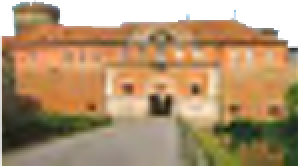Travel Reference
In-Depth Information
Kurfürstendamm
The famous Berlin boulevard,
the pride of Charlottenburg, is
today more elegant than ever
(see pp24-5).
a prison in the 19th century. At
the time, Berliners used to say,
“off to the Julio , when they sent
criminals to prison. Later the
imperial war treasures were kept
here - the reparations
paid by France to the
German Empire after its
defeat in the Franco-
Prussian War of 1870-1.
The Bastion Königin
houses a museum of
municipal history.
d
Am
Juliusturm
•
9am-5pm Tue-Fri,
10am-5pm Sat, Sun
•
(030) 354
944 200
•
Admission charge
Schloss
Charlottenburg
The Baroque and Eng-
lish-style gardens of this
Hohenzollern summer
residence are ideal for
a stroll
(see pp28-31).
d
Spandauer Damm
•
Map
A/B3
•
opening hours see
p28
•
(030) 20 90 55 66
•
Admission charge
Spandau
Old Town
When walking around
Spandau Old Town, it is easy to
forget that you are still in Berlin.
Narrow alleyways and nooks and
crannies around Nikolaikirche are
lined by Late Medieval houses, a
sign that Spandau was founded
in 1197 and is thus older than
Berlin itself. Berlin's oldest
house, the Gothic House, dating
back to the early 16th century,
stands here, in Breite Straße 32.
d
Breite Straße, Spandau
Inside Nikolaikirche,
Spandau Old Town
Zoologischer
Garten
Germany's largest and oldest
zoological garden is a must for
all families on a visit to Berlin
(see pp36-37)
.
Zitadelle Spandau
The only surviving fortress in
Berlin, the citadel, at the conflu-
ence of the Havel and Spree
Rivers, is strategically well
placed. The star-shaped moated
fortress, built in 1560 by Fran-
cesco Chiaramella da Gandino,
was modelled on similar build-
ings in Italy. Its four powerful
corner bastions, named Bran-
denburg, König (king), Königin
(queen) and Kronprinz (crown
prince) are especially remark-
able. A fortress stood on the
same site as early as the 12th
century, of which the Juliusturm
survives - a keep that served as
Spandau and Berlin
West Berliners consider the
Spandauers to be rather different
sorts of people, provincial and
rough, and not “real” Berliners at
all. But the Spandauers can reas-
sure themselves that Spandau is
60 years older than Berlin, and
proudly point to their independent
history. The mutual mistrust is not
just a consequence of Spandau's
geographical location, isolated
from the remainder of the city by
the Havel and Spree Rivers. It is
also due to the recent incorpora-
tion of Spandau in 1920. Today,
still, Spandauers say they are
going “to Berlin , even though the
centre of the city is only a few
stops away on the U-Bahn.
Zitadelle Spandau
Spandau:
www.Berlin.de/ba-spandau/index.html
79












